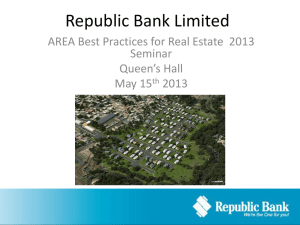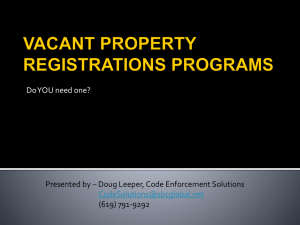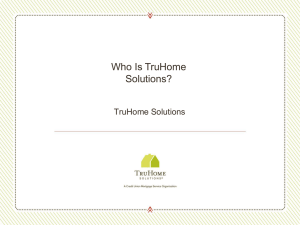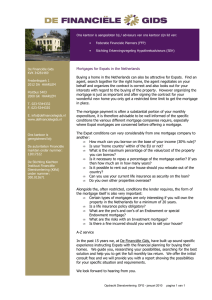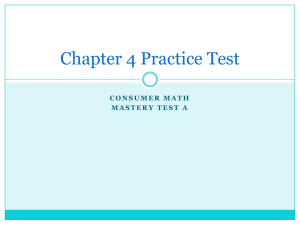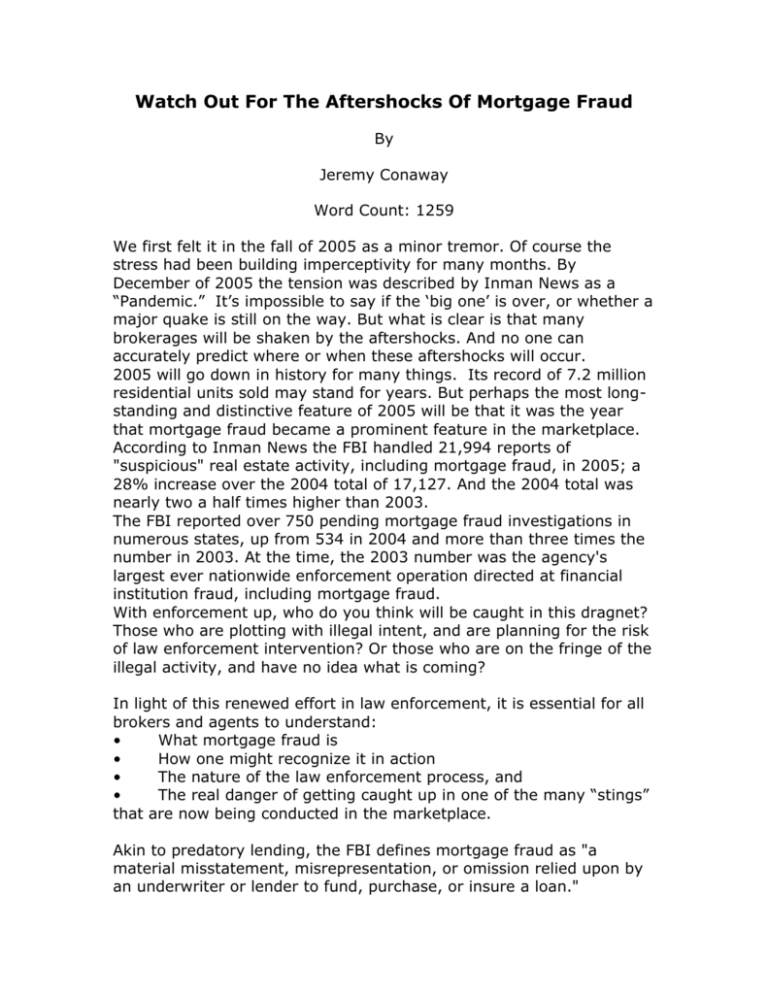
Watch Out For The Aftershocks Of Mortgage Fraud
By
Jeremy Conaway
Word Count: 1259
We first felt it in the fall of 2005 as a minor tremor. Of course the
stress had been building imperceptivity for many months. By
December of 2005 the tension was described by Inman News as a
“Pandemic.” It’s impossible to say if the ‘big one’ is over, or whether a
major quake is still on the way. But what is clear is that many
brokerages will be shaken by the aftershocks. And no one can
accurately predict where or when these aftershocks will occur.
2005 will go down in history for many things. Its record of 7.2 million
residential units sold may stand for years. But perhaps the most longstanding and distinctive feature of 2005 will be that it was the year
that mortgage fraud became a prominent feature in the marketplace.
According to Inman News the FBI handled 21,994 reports of
"suspicious" real estate activity, including mortgage fraud, in 2005; a
28% increase over the 2004 total of 17,127. And the 2004 total was
nearly two a half times higher than 2003.
The FBI reported over 750 pending mortgage fraud investigations in
numerous states, up from 534 in 2004 and more than three times the
number in 2003. At the time, the 2003 number was the agency's
largest ever nationwide enforcement operation directed at financial
institution fraud, including mortgage fraud.
With enforcement up, who do you think will be caught in this dragnet?
Those who are plotting with illegal intent, and are planning for the risk
of law enforcement intervention? Or those who are on the fringe of the
illegal activity, and have no idea what is coming?
In light of this renewed effort in law enforcement, it is essential for all
brokers and agents to understand:
•
What mortgage fraud is
•
How one might recognize it in action
•
The nature of the law enforcement process, and
•
The real danger of getting caught up in one of the many “stings”
that are now being conducted in the marketplace.
Akin to predatory lending, the FBI defines mortgage fraud as "a
material misstatement, misrepresentation, or omission relied upon by
an underwriter or lender to fund, purchase, or insure a loan."
According to Ralph Roberts, a Michigan real estate broker, who has
become a nationally recognized anti-fraud advocate, the illegal
behavior comes in several forms involving bad actors who:
•
Pay "straw borrowers" or "investors" to sign and submit
documents containing false qualifying information.
•
Induce appraisers to inflate property values in order to obtain a
larger mortgage loan for the "straw borrower."
•
Submit bogus invoices for phantom "upgrades" or "renovations"
that falsely inflate the value of the property.
•
Promise "investors" that properties will be leased or rented, and
that they will pay all mortgage, insurance, property tax and
homeowner association payments for those investors. (Of course these
tenants never materialize and the payments are never made).
•
Pay "straw sellers" to falsely claim ownership of a property,
appear at a closing where the property is sold to "straw borrowers,"
distribute the mortgage proceeds inappropriately and subsequently
appear at the next closing (sometimes within hours) to purchase the
same property at a lesser amount, (this is, of course, the classic act of
“flipping”)
•
Provide buyers with funds for down payments that are falsely
represented as being paid by the borrower.
•
Create "false sellers" and "false borrowers" to assume false
identities for the purpose of fraudulently obtaining mortgage loan
proceeds.
•
File false release, cancellation and assignment of security deeds
on properties to eliminate the security interest of legitimate lenders in
order to clear title prior to obtaining additional mortgage loans on the
property.
While the above behaviors are the most common, like other
popular crimes, mortgage fraud comes in an endless range of
variations as more bad actors apply their creativity and innovation to
the illegal activity.
Mortgage fraud has never been a sexy or glamorous crime. In fact
despite its statistical growth over the past several years, until 2005 it
had not received the full attention of law enforcement. Surprisingly,
as the crime grows, more suspects are walking. There were 206
indictments in 2005, down from 241 in 2004. And there were 170
related convictions in 2005, down from 172 in 2004.
Today mortgage fraud is a priority within the federal and state law
enforcement community. It is now receiving a level of treatment that
will redefine the crime.
Public education about criminal behavior is often frustrating and nonproductive because the public fails to see the relevancy of the crime.
The vast majority of real estate and mortgage professionals would not
willingly participate in mortgage fraud. But they might be involved
unknowingly. In order to make their newfound seriousness “relevant”
to all practitioners, it is necessary for law enforcement to create
“relevant examples” that are worthy of headline coverage, and clearly
teach the lessons.
Activities that constitute violations of any criminal statute are like the
four concentric circles of a target. In the middle “bull’s eye” are the
worst offenders, the true criminal element. In the second ring there
are the amateur criminals who are just opportunists. In the third ring
are those who just practice in a sloppy manner. And in the fourth ring
are those who are just trying to “get by” in a complicated world.
A classic example of this target concept is our common experience of
speeding in a car. The “bull’s eye” group goes 95 in a 55 zone and
everyone is offended. The second group goes 85 and everybody
notices. The third group goes 75 and everyone wonders. The fourth
group however believes in the “7 over” rule and believes that 62 MPH
is really all right.
Unfortunately many professionals whose arrest will make the
enforcement effort “relevant” are in this last group. The current
mortgage fraud “sting” environment will generate its publicity not on
the most grievous of offenders but rather upon the arrest of high
profile agents, large brokers and generally “straight shooters” whose
violations, although “somewhat technical” will generate public
attention to the problem.
Most distressing is that many of these “technical” violations occur
because the offenders do not realize that “cutting” corners (going 56 in
a 55) will now be picked up by the law enforcement radar. “Ignorance
of the law” is not a substantive defense.
Brokers should immediately review the mortgage procedures being
used by in-house mortgage programs, and more to the point, by
agents who may be using mortgage resources of a lesser more
personal quality.
It is time to once again consider the benefits of a strong core
mortgage program.
Don’t slide into simple violations that become the basis of an
appearance on the front page of the local newspaper and an
appointment with a federal judge. Beware. Review and exercise your
management and control procedures.
The time is now to prepare to protect ourselves, and our clients. We
an not stop the aftershocks. But we can build solid and flexible policies
to keep our structures from crumbling.
Jeremy Conaway is the President of RECON Intelligence Services. He is
a recognized expert in the fields of brokerage and association design.
His company is currently a leading source of strategic and tactical
ideas and applications for the leading edge of the real estate industry.
He is a nationally known lecturer, author and facilitator. Copyright©
2006, Jeremy Conaway. All rights reserved. For information regarding
Jeremy’s speaking, consulting and facilitating, contact the FrogPond at
800.704.FROG(3764) or email susie@FrogPond.com;
http://www.FrogPond.com




